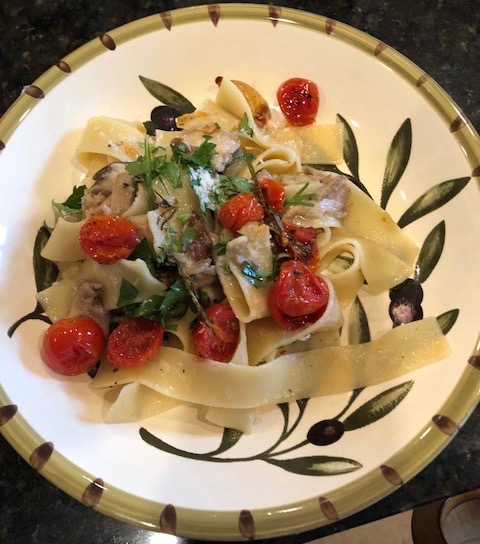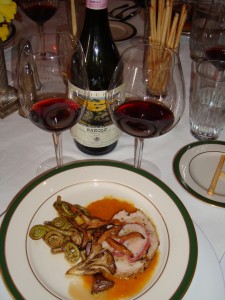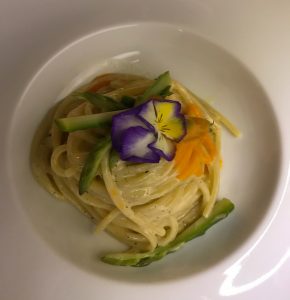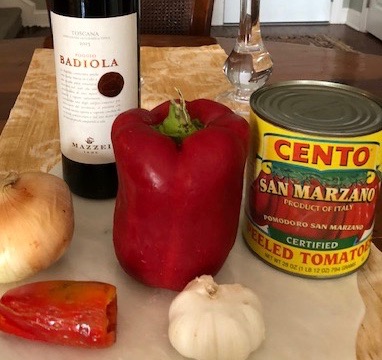Happy Father’s Day to all the dads and grand dads everywhere! And since I qualify in both categories, I put in my request for a Father’s Day meal a few weeks back. As a matter of fact, I actually cooked the delicious dish I am sharing with you today back then. I want it again!
I know, I know… most of you guys out there in father land are probably going to be celebrating our day by eating a large piece of cow meat. And while I might just fire up the grill this afternoon for an accompanying rib eye, I’m definitely going to make my mushroom and pea pappardelle pasta dish the centerpiece of this hallowed holiday.
So if it’s too late for your chef de cuisine to change the meal plan today - or to add to the holiday menu - hang on to the recipe below because it is a WINNER! But whenever you decide to try the dish, be advised that while I would opt for a full-bodied white wine to pair it with, you could also accompany it with a silky red.

Here are my white and red wine suggestions for this exquisite pasta dish.
2016 Mastroberadino Fiano di Avellino ($30)- One of the characteristics of this white wine from the Campania region of Italy (in the hills above Naples) is the nutty, round and rich flavors of Fiano. It also has some citrus and mineral notes and should be a perfect match to the complex flavors in the pasta dish. If you can’t find Fiano, you can substitute it with a white like friulano or even a rich chardonnay.
2016 Allegrini Valpolicella Classico ($17) – This lighter-styled, silky red is full of fruit forward and ripe cherry flavors. It is perfectly balanced and refreshing with enough acid to be a counterpoint to the richness of the pasta.
Mushroom and Peas Pappardelle
One pound of pappardelle pasta
One half pound of mixed mushrooms (shitake, oyster, baby portabella, etc.)
Three ounces of extra virgin olive oil
One tablespoon of butter
One small Vidalia onion and one clove of garlic
Four ounces of green peas (preferably fresh spring peas)
One-half cup of chicken stock
Three ounces of dry white wine
Three tablespoons of heavy cream
One tablespoon each of kosher salt and freshly ground black pepper
One tablespoon of chopped Italian parsley
One teaspoon of red pepper flakes (optional)
Eight or ten cherry tomatoes
Grate one-half pound of Parmigiano Reggiano (or other good grating cheese)
Slice tomatoes in half and thinly slice the onion and garlic
Shuck fresh peas or thaw out frozen green peas
Clean mushrooms with a damp cloth and slice into quarter inch pieces
Sauté onions in olive oil and half the butter until translucent
Add peas, mushrooms and garlic to sauté pan and cook for about three minutes
Pour in chicken stock and white wine and cook for about five minutes
Turn heat down to simmer
Add pappardelle to boiling water and cook until al dente
Drain pappardelle reserving one-half cup pasta water
Add pasta to the simmering mushrooms and peas
Add the remaining butter and pour in heavy cream and pasta water
Sprinkle in the salt, pepper and red pepper flakes
Add the cheese and toss the mixture until it’s all integrated
Sprinkle parsley and more cheese on each plate of pasta
Serve immediately
Buon Appetito!
I know, I know… most of you guys out there in father land are probably going to be celebrating our day by eating a large piece of cow meat. And while I might just fire up the grill this afternoon for an accompanying rib eye, I’m definitely going to make my mushroom and pea pappardelle pasta dish the centerpiece of this hallowed holiday.
So if it’s too late for your chef de cuisine to change the meal plan today - or to add to the holiday menu - hang on to the recipe below because it is a WINNER! But whenever you decide to try the dish, be advised that while I would opt for a full-bodied white wine to pair it with, you could also accompany it with a silky red.

Here are my white and red wine suggestions for this exquisite pasta dish.
2016 Mastroberadino Fiano di Avellino ($30)- One of the characteristics of this white wine from the Campania region of Italy (in the hills above Naples) is the nutty, round and rich flavors of Fiano. It also has some citrus and mineral notes and should be a perfect match to the complex flavors in the pasta dish. If you can’t find Fiano, you can substitute it with a white like friulano or even a rich chardonnay.
2016 Allegrini Valpolicella Classico ($17) – This lighter-styled, silky red is full of fruit forward and ripe cherry flavors. It is perfectly balanced and refreshing with enough acid to be a counterpoint to the richness of the pasta.
Mushroom and Peas Pappardelle
One pound of pappardelle pasta
One half pound of mixed mushrooms (shitake, oyster, baby portabella, etc.)
Three ounces of extra virgin olive oil
One tablespoon of butter
One small Vidalia onion and one clove of garlic
Four ounces of green peas (preferably fresh spring peas)
One-half cup of chicken stock
Three ounces of dry white wine
Three tablespoons of heavy cream
One tablespoon each of kosher salt and freshly ground black pepper
One tablespoon of chopped Italian parsley
One teaspoon of red pepper flakes (optional)
Eight or ten cherry tomatoes
Grate one-half pound of Parmigiano Reggiano (or other good grating cheese)
Slice tomatoes in half and thinly slice the onion and garlic
Shuck fresh peas or thaw out frozen green peas
Clean mushrooms with a damp cloth and slice into quarter inch pieces
Sauté onions in olive oil and half the butter until translucent
Add peas, mushrooms and garlic to sauté pan and cook for about three minutes
Pour in chicken stock and white wine and cook for about five minutes
Turn heat down to simmer
Add pappardelle to boiling water and cook until al dente
Drain pappardelle reserving one-half cup pasta water
Add pasta to the simmering mushrooms and peas
Add the remaining butter and pour in heavy cream and pasta water
Sprinkle in the salt, pepper and red pepper flakes
Add the cheese and toss the mixture until it’s all integrated
Sprinkle parsley and more cheese on each plate of pasta
Serve immediately
Buon Appetito!




